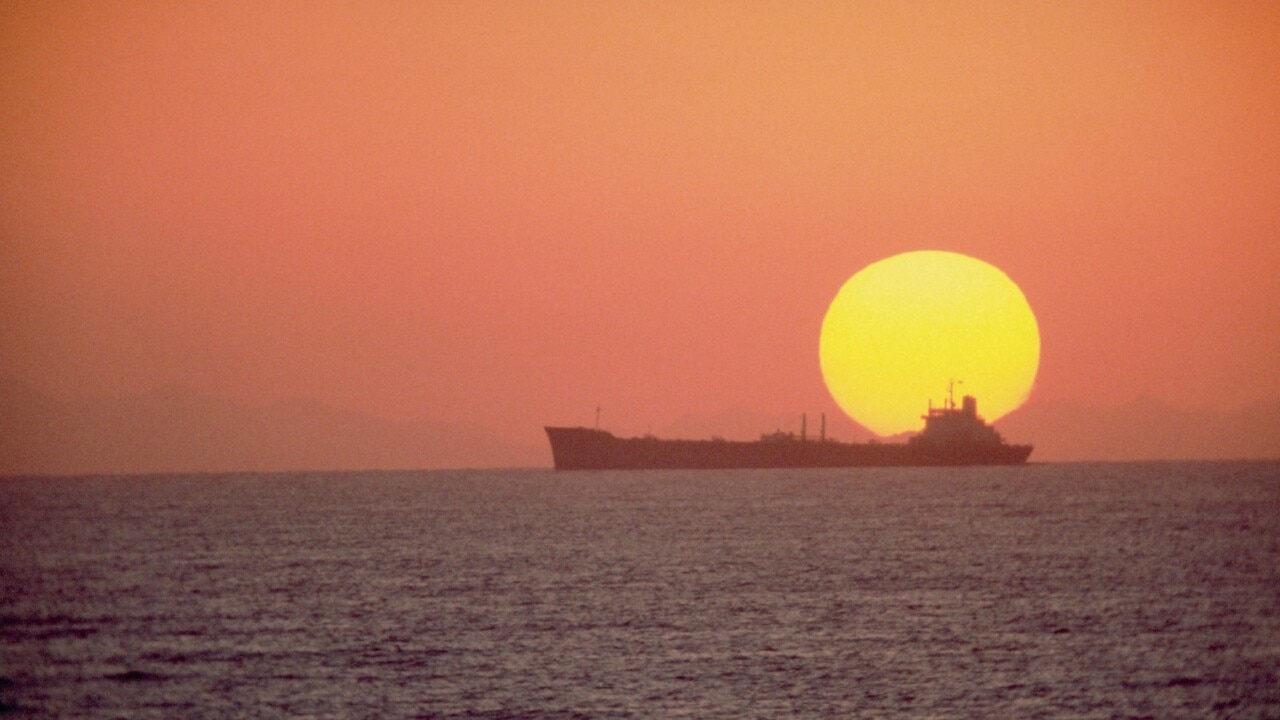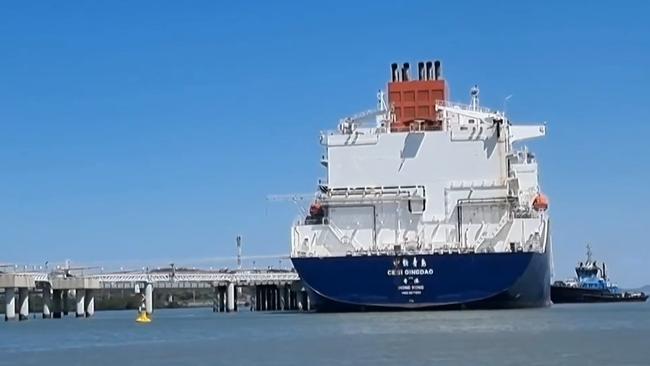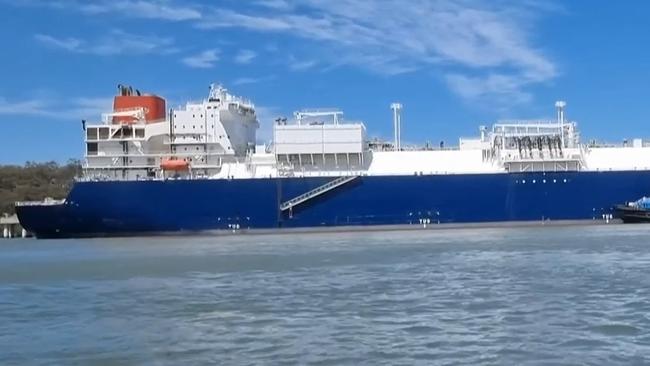How broken liquid gas tanker blocked Qld port in Gladstone
There are warnings of potential “catastrophic consequences” as an LNG tanker remains detained off the coast of Gladstone. UPDATES.

Rockhampton
Don't miss out on the headlines from Rockhampton. Followed categories will be added to My News.
A LNG tanker has been repaired off the coast of Gladstone after it lost power but there could have been “catastrophic consequences” if the liquified gas warmed up, an expert warned.
The Hong Kong flagged LNG tanker Cesi Qingdao had been sitting in Gladstone Harbour for more than a week as of Friday morning (December 1) after it was detained by the Australian Maritime Safety Authority (AMSA) following a vessel blackout.
AMSA was alerted to the incident and after inspecting the ship deemed it unseaworthy.
After days of blocking other LNG tankers, AMSA granted permission under the detention order to allow for the ship to move from the terminal to a safe anchorage.
Operations have since resumed at the terminal.

The Cesi Qingdao departed the Curtis Island LNG terminal in Gladstone Harbour with the help of Port of Gladstone tugs and pilot vessels about 11am on Friday, December 1 and was anchored on the eastern side of Facing Island by the afternoon.
The island is 12km off the Gladstone mainland.
An AMSA spokesperson said they were confident there is minimal risk of environmental impact from the ship at anchor and referred all questions about the ship’s operation to the vessel operator.
China Energy Ship Management manages the Cesi Qingdao.
AMSA said repairs would continue while the tanker was anchored.
The Gladstone Ports Corporation has not responded to questions from this publication.
It is understood there was power on the vessel when it left the LNG facility.
The LNG was not stored under pressure and is reportedly not explosive when stored in tanks or on ships.
“Just highlights how dangerous it is”
The Australia Institute gas industry expert Mark Ogge said this event could have had catastrophic consequences for Gladstone.
“In this case they have towed it out to sea, so it’s not a risk to people in Gladstone but the fact that this could happen … they lost power, they have to keep it cool and have to release it in port, just highlights how dangerous it is.”
Mr Ogge said the liquified gas needed to be refrigerated at -160 degrees, otherwise it risked expanding and exploding.
It is unclear if the tanker has power to it where it has been towed out to sea.
Mr Ogge said it takes a huge amount of power to keep it refrigerated.
“If it comes into contact with an ignition source, consequences are catastrophic,” Mr Ogge said.
“This situation highlights the enormous risk that LNG poses to the community.
He said there was plenty of footage of gas explosions in the US, and they are catastrophic.
“This is yet another example of the Gladstone community bearing the risk and costs of the gas export facilities and getting very few benefits,” Mr Ogge said.
“These companies are making billions of dollars annually, they by-and-large dont pay any tax and they have a very disruptive impact on local economies.
“The residents of Gladstone are bearing a lot of the risk and downside without receiving much benefit.”

No injuries, unable to leave on time
ConocoPhilips Australia confirmed the LNG vessel docked at the Australia Pacific LNG (APLNG) facility lost power and was unable to leave the terminal as scheduled.
“AMSA is confident there is minimal risk of environmental impact from the ship at anchor,” they said.
However, the ship remains under AMSA administrative detention until the repairs are completed.
Gas operator ConocoPhillips Australia confirmed the LNG vessel docked at the Australia Pacific LNG (APLNG) facility lost power and was unable to leave the terminal as scheduled.
Co-owner Origin Energy said at least two LNG cargoes had been delayed and more would be while the tanker blocked other vessels.
ConocoPhillips Australia stated it had assessed and planned for scenarios to best manage the supply through the APLNG facility while the situation was being resolved, deferring cargoes from entering the facility on Curtis Island off Australia’s east coast.
They said there were no injuries to personnel on the vessel or at the LNG facility from the event and they been working with the ship captain and management, local and federal regulators, and the customer to respond to this event.
Maritime Safety Queensland (MSQ) and the Regional Harbour Master were also working with them to ensure that repairs are undertaken as quickly as possible, to monitor the welfare of the crew, and to prevent disruption to normal shipping.
Origin reducing flow of gas
Origin, as upstream operator, was maintaining supply to the domestic market and reducing the flow of gas to the LNG facility, according to ConocoPhillips Australia earlier this week.
The vessel, built in 2017, holds a capacity of 174,000 cubic metres of LNG and the registered owner is China Energy Hope LNG.
Marine traffic data for the CESI Qingdao shows it is still at the Gladstone Port and has “restricted manoeuvrability” with the reported destination at Wenzhou China.
It appears it may make the trip to east Australia often and was previously reported at Gladstone on October 26.
Gladstone is the only place in eastern Australia where gas can be exported.
There are three LNG export terminals at Gladstone that are fed by coal seam gas fields throughout Queensland.
The gas is mostly used for industrial electricity generation in Asian countries, Mr Ogge said.
“These are the risks you have when you allow huge scale coal seam gas fracking and exports.”
Cargo ship ban at Port Alma
Earlier this month AMSA banned a ship it inspected at Port Alma near Rockhampton.
The Briese Heavylift GmbH & Co ship, Antigua and Barbuda general cargo ship BBC Jade, was found to have 57 tonnes of explosive incorrectly stowed during an inspection.
According to AMSA, Briese Heavylift GmbH & Co has a “history of poor performance and multiple warnings”.
AMSA Acting Executive Director of Operations Evan Boyle said that this latest breach, along with the ongoing poor performance of the operator, meant that a ban was necessary.
“Seafarers, and the Australian community, should feel confident that explosive substances are transported safely,” he said.
“Australian companies which are shipping dangerous cargo such as explosives to Australia may wish to exercise further diligence in whose vessels they engage to carry them.
“This is a serious maritime safety issue, as well as a major environmental concern, and not something that should be taken lightly.
“Australia will not tolerate this ongoing and blatant disregard for maritime safety,” he said.
“We take our role as a regulator seriously, and we expect operators to take their obligations seriously, as well.
“We will not hesitate to take tough enforcement action to keep our seas, and seafarers, safe.”




